Related Research Articles
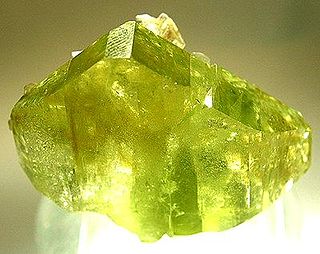
Brazilianite, whose name derives from its country of origin, Brazil, is a typically yellow-green phosphate mineral, most commonly found in phosphate-rich pegmatites.

Triplite is a rare phosphate mineral with formula: (Mn, Fe)2PO4(F, OH). It occurs in phosphate-rich granitic pegmatites typically as irregular brown opaque masses. Triplite was first described in 1813 for an occurrence in Chanteloube, Limousin, France. The name is from the Greek triplos for triple, in reference to the three cleavage directions. In color and appearance, it is very similar to rhodocrosite, another manganese bearing mineral. Chemically, it is also quite similar to triploidite the difference being that triplite is fluorine dominant while triploidite is hydroxide dominant.

Lithiophilite is a mineral containing the element lithium. It is lithium manganese(II) phosphate with chemical formula LiMnPO4. It occurs in pegmatites often associated with triphylite, the iron end member in a solid solution series. The mineral with intermediate composition is known as sicklerite and has the chemical formula Li(Mn,Fe)PO4). The name lithiophilite is derived from the Greek philos (φιλός) "friend", as lithiophilite is usually found with lithium.

Thorianite is a rare thorium oxide mineral, ThO2. It was originally described by Ananda Coomaraswamy in 1904 as uraninite, but recognized as a new species by Wyndham R. Dunstan. It was so named by Dunstan on account of its high percentage of thorium; it also contains the oxides of uranium, lanthanum, cerium, praseodymium and neodymium. Helium is present, and the mineral is slightly less radioactive than pitchblende, but is harder to shield due to its high energy gamma rays. It is common in the alluvial gem-gravels of Sri Lanka, where it occurs mostly as water worn, small, heavy, black, cubic crystals. The largest crystals are usually near 1.5 cm. Larger crystals, up to 6 cm (2.4 in), have been reported from Madagascar.

Bismutite or bismuthite is a bismuth carbonate mineral with formula Bi2(CO3)O2 (bismuth subcarbonate). Bismutite occurs as an oxidation product of other bismuth minerals such as bismuthinite and native bismuth in hydrothermal veins and pegmatites. It crystallizes in the orthorhombic system and typically occurs as earthy to fibrous masses.
Tantite is a rare tantalum oxide mineral with formula: Ta2O5. Tantite forms transparent microscopic colorless triclinic - pedial crystals with an adamantine luster. It has a Mohs hardness of 7 and a high specific gravity of 8.45. Chemical analyses show minor inclusion (1.3%) of niobium oxide.
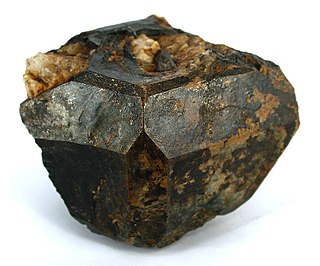
Microlite was once known as a pale-yellow, reddish-brown, or black isometric mineral composed of sodium calcium tantalum oxide with a small amount of fluorine. Its chemical formula is (Na,Ca)2Ta2O6(O,OH,F). Today it is a name of a group of oxide minerals of a similar stoichiometry having tantalum prevailing over titanium and niobium. The microlite group belongs to a large pyrochlore supergroup that occurs in pegmatites and constitutes an ore of tantalum. It has a Mohs hardness of 5.5 and a variable specific gravity of 4.2 to 6.4. It occurs as disseminated microscopic subtranslucent to opaque octahedral crystals with a refractive index of 2.0 to 2.2. Microlite is also called djalmaite, but both names are now obsolete.

Lorenzenite is a rare sodium titanium silicate mineral with the formula Na2Ti2Si2O9 It is an orthorhombic mineral, variously found as colorless, grey, pinkish, or brown crystals.

Loparite-(Ce) is a granular, brittle oxide mineral of the perovskite class. It is black to dark grey and may appear grey to white in reflected light on polished thin section with reddish brown internal reflections. It has the chemical formula of (Ce,Na,Ca)(Ti,Nb)O3. Nioboloparite is a variation of loparite-(Ce) containing niobium.

Betafite is a mineral group in the pyrochlore supergroup, with the chemical formula (Ca,U)2(Ti,Nb,Ta)2O6(OH). Betafite typically occurs as a primary mineral in granite pegmatites, rarely in carbonatites. Originally defined by the B-site atom Ti, the development of new nomenclature for mineral names led to modernization of the system for nomenclature of pyrochlore and betafite in order to further rationalize the naming process of this grouping of minerals. Only two of the mineral species that were formerly recognized as betafite are presently retained. They are oxyuranobetafite and oxycalciobetafite. The term betafite is now a synonym or varietal group name under the pyrochlore super group.
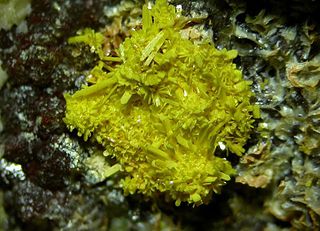
Bergenite is a rare uranyl phosphate of the more specific phosphuranylite group. The phosphuranylite-type sheet in bergenite is a new isomer of the group, with the uranyl phosphate tetrahedra varying in an up-up-down, same-same-opposite (uuduudSSOSSO) orientation. All bergenite samples have been found in old mine dump sites. Uranyl minerals are a large constituent of uranium deposits.
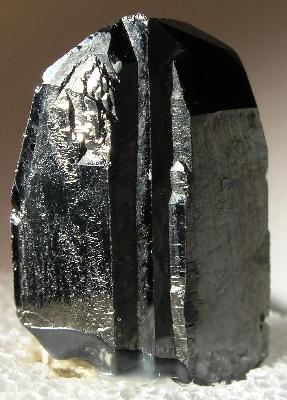
Wodginite is a manganese, tin, tantalum oxide mineral with the chemical formula Mn2+(Sn,Ta)Ta2O8. It may also include significant amounts of niobium.
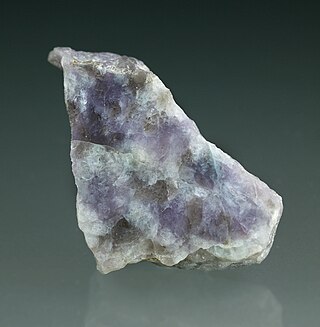
Rubicline, also referred to as Rb-microcline, is the rubidium analogue of microcline, an important tectosilicate mineral. Its chemical formula is (Rb, K)[AlSi3O8] with an ideal composition of RbAlSi3O8. Chemical analysis by electron microprobe indicated the average weight of the crystal is 56.66% SiO2, 16.95% Al2O3, and 23.77% Rb2O, along with trace amounts of caesium oxide (Cs2O) and iron(III) oxide (Fe2O3).

Boltwoodite is a hydrated uranyl silicate mineral with formula (K0.56Na0.42)[(UO2)(SiO3OH)]·1.5(H2O), distinct in crystal structure from sodium boltwoodite, which has an orthorhombic structure rather than monoclinic. It is formed from the oxidation and alteration of primary uranium ores. It takes the form of a crust on some sandstones that bear uranium. These crusts tend to be yellowish with a silky or vitreous luster.

Zemannite is a very rare oxide mineral with the chemical formula Mg0.5ZnFe3+[TeO3]3·4.5H2O. It crystallizes in the hexagonal crystal system and forms small prismatic brown crystals. Because of the rarity and small crystal size, zemannite has no applications and serves as a collector's item.
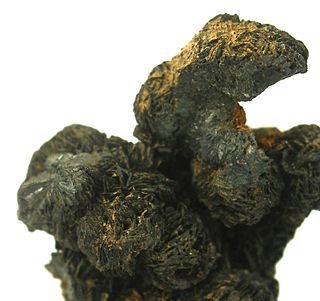
Hagendorfite is an iron phosphate mineral with the chemical formula of (Na,Ca)MnFe2(PO4)3 and is named after where the mineral was discovered, Hagendorf-Süd, Bavaria, Germany.

Serandite is a mineral with formula Na(Mn2+,Ca)2Si3O8(OH). The mineral was discovered in Guinea in 1931 and named for J. M. Sérand. Serandite is generally red, brown, black or colorless. The correct name lacks an accent.
Bobfergusonite is a mineral with formula Na2Mn5FeAl(PO4)6. The mineral varies in color from green-brown to red-brown. It was discovered in 1986 in Manitoba, Canada, and named for Robert Bury Ferguson (1920–2015), a professor of geological sciences at the University of Manitoba. As of 2012, the mineral has only been found in Canada and Argentina.

Ixiolite is an accessory oxide mineral found in granitic pegmatites. It is an oxide with the general chemical formula (Ta,Nb,Sn,Mn,Fe)4O8 or (Ta,Mn,Nb)O2.

Béhierite is a very rare mineral, the tantalum endmember of a borate solid solution series with formula (Ta,Nb)BO4. The niobium analogue is schiavinatoite.
References
- ↑ Warr, L.N. (2021). "IMA–CNMNC approved mineral symbols". Mineralogical Magazine. 85 (3): 291–320. Bibcode:2021MinM...85..291W. doi: 10.1180/mgm.2021.43 . S2CID 235729616.
- ↑ Mineralienatlas
- 1 2 Billwiseite on Mindat.org
- 1 2 3 4 Hawthorne, F. C.; Cooper, M. A.; Ball, N. A.; Abdu, Y. A.; Cerny, P.; Camara, F.; Laurs, B. M. (2012). "Billwiseite, Ideally Sb3+5(Nb,Ta)3WO18, A New Oxide Mineral Species from the Stak Nala Pegmatite, Nanga Parbat - Haramosh Massif, Pakistan: Description and Crystal Structure". The Canadian Mineralogist. 50 (4): 805–814. Bibcode:2012CaMin..50..805H. doi:10.3749/canmin.50.4.805. ISSN 0008-4476.